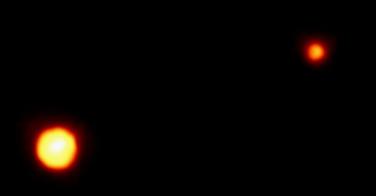Dwarf planet Pluto has a single large moon named Charon, discovered in 1978.
To see why it probably isn't really a moon, think about orbits: It isn't true to say: "X orbits around Y," though we do it all the time. The truth is that in every two-body system, both objects orbit around their common center of mass. Most planetary-mass objects are so much bigger than their moons that the distinction doesn't matter for most purposes.
Charon is about one-seventh the mass of Pluto. It's about half Pluto's size. And it maintains an orbital distance from Pluto of just 19,400 kilometers (11,600 miles). That's very close, astronomically.
In every other planet-moon pair we know of, the common center of mass is somewhere inside the planet. (Astrophysicists call the planet the parent body.) But the common center of mass of Pluto and Charon is at a point in space between the two, not inside either of them.
Pluto's rotational period matches Charon's orbital period. They always have the same faces towards each other, locked in by tidal forces.
_t.jpg)
